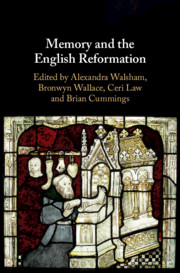Book contents
- Memory and the English Reformation
- Memory and the English Reformation
- Copyright page
- Dedication
- Contents
- Figures
- Contributors
- Preface and Acknowledgements
- Abbreviations
- Introduction
- Part I Events and Temporalities
- Part II Objects and Places
- 7 Dolls and Idols in the English Reformation
- 8 Monuments and the Reformation
- 9 Memorable Motifs
- 10 Revitalising Antiquities
- 11 Rereading Ruins
- 12 ‘Monuments of Our Indignation’
- Part III Lives and Afterlives
- Part IV Rituals and Bodies
- Index
11 - Rereading Ruins
Edmund Spenser and Scottish Presbyterianism
from Part II - Objects and Places
Published online by Cambridge University Press: 30 October 2020
- Memory and the English Reformation
- Memory and the English Reformation
- Copyright page
- Dedication
- Contents
- Figures
- Contributors
- Preface and Acknowledgements
- Abbreviations
- Introduction
- Part I Events and Temporalities
- Part II Objects and Places
- 7 Dolls and Idols in the English Reformation
- 8 Monuments and the Reformation
- 9 Memorable Motifs
- 10 Revitalising Antiquities
- 11 Rereading Ruins
- 12 ‘Monuments of Our Indignation’
- Part III Lives and Afterlives
- Part IV Rituals and Bodies
- Index
Summary
With a focus on Edmund Spenser, this chapter explores representations of ruined monasteries within (New) English protestant writing of c.1590-1642. Monastic ruins are visible mnemonics of British-Irish reformation, and Protestants express surprisingly broad motivations for their remembrance, from sorrow for, to celebration of, monastic dissolution – a breadth of opinion reflecting the breadth of beliefs and practices within the Elizabethan/early Stuart church. Recognition of this confessional latitude is leading to reappraisal of Spenser’s own ‘puritan’ credentials, and to realisation that Spenser was as anti-Presbyterian as he was anti-Catholic. The chapter is the first to translate Spenser’s Presbyterian anxieties to a Scottish context, arguing that Spenser’s famously fractious relationship with James VI was prompted as much by Spenser’s anxieties over James’s seeming support for Scottish Presbyterians as by Spenser’s attack on James’s Catholic mother. The chapter shows how, in Faerie Queene VI, Spenser evokes memories of monastic ruins to warn his generation against the prospect of further, Presbyterian-led ruination in England and Ireland under a future Scottish king. This perspective on monastic ruins – as memories of past, and monitories against future, reformation – serves as a salutary reminder that ‘reformation’ was a protracted and by no means universally popular process for Spenser’s generation.
Keywords
- Type
- Chapter
- Information
- Memory and the English Reformation , pp. 223 - 237Publisher: Cambridge University PressPrint publication year: 2020

